#shibori style
Text

My moss bed has a lot more decorative stuff now; more than double what it started out with. I've picked up three more leaves, two mushrooms, and a Crow Time plushie for it. I'm also eyeing an oversized fox plushie as something to maybe get. Though I might wait until the fall for any further additions, as we're starting to get into warm enough weather that things like the duvet and its shaggy cover will be going into storage soon, as will all the pillows except the flower. Because, as previously mentioned, its bowl-like shape makes it a great rallying point for things like my reading glasses, cell phone, bluetooth speaker, and so forth.
(Yes, the desire for the oversized fox is absolutely based on liking the recent Crow Time comics sequence where the crow is journeying with a fox. 1 | 2 | 3)
#Moss Bed#Crow Time#Of the several sets of stuff I have for my bed now this is by far my favourite#Might pick up some indigo shibori throw pillows to go with the comforter I have in that style#Now I've gotten used to having some throw pillows around
10 notes
·
View notes
Photo

Dining Room - Beach Style Dining Room
Large beach style light wood floor and beige floor enclosed dining room photo with blue walls and no fireplace
0 notes
Text
Somewhat New Age. ALTUZARRA Ready To Wear Spring 2023

Joseph Altuzarra reveals that the beginning of the Spring 2023 collection was reading the 1968 book "The Teachings of Don Juan" by Carlos Castaneda, which launched the New Age movement.
This book dealing with shamanism, esotericism and magic prompted the designer to search for magic in life and venture beyond the borderline of reality and imagination.
Altuzarra was moved by Castaneda's musings as well as an autobiographical work by another author, Edward Abbey, titled “Desert Solitaire”, a book based on the author's activities as a ranger at Arches National Park in Utah.
As a result, a collection was created that we can call a travel collection. It's the result of the evolution of sportswear explicitly designed for 'fearless explorers'.
For these explorers there was a blazer dressed over a classic navy blue jumper with a round neckline and a striped button down shirt - combined with loosely tied skirts. Or tiny vests plus jackets with corset fastenings, pleated skirts, knitwear, denim and button-up trousers.


















The show started with preppy classics like striped shirts, cable-knit sweaters and miniskirts - but modified so that they were neither preppy nor classic anymore. Altuzarra completed them with boxy jackets or parkas and added Keds sneakers. And denim in the collection is the first experiments with this material.
The shibori-dyed dress (Blesnya Minher) symbolizes the encounter with nature.
Esotericism is symbolized by luxurious, artistic outfits with psychedelic riffs obtained using the shibori technique, "hypnotic" prints and metallic trimmings. A range of hallucinogenic hues appeared on both body-hugging and airy dresses, knitwear, tie-front shirts with fitted miniskirts, tunics and parkas.
Some dresses were first dyed using the tie-dye method, then pleated and twisted. Others were sewn first and then dyed, which required two months of work.
Fall's cascading pailettes have turned into embellishments in layered final looks. We can find in them the symbolism of the Tao - Altuzarra decorated his parks with large trinkets and mandalas of smaller metal discs, bells and beads. A bit of magic in tailoring.
Photo: Altuzarra/Tagwalk
#altuzarra#josephaltuzarra#newyorkfashionweek#newyorkfashion#fashion#fashionstyle#fashiondesigner#fashionshow#fashionrunway#styles#luxuryfashion#shibori#tiedye#readytowear#fashionbrand
0 notes
Text
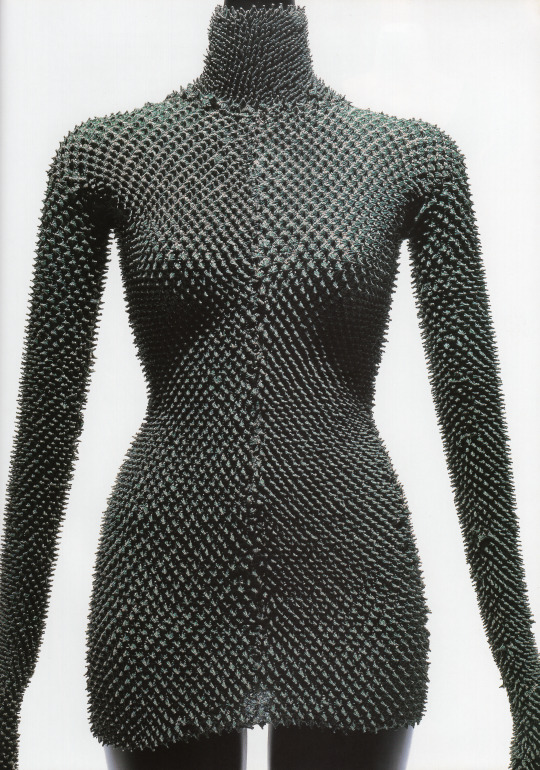
Maurizio Galante autumn/winter (1994)
Pullover dress made from 'shibori', a japanese twisted and dyed silk fabric which gives it a relatively feel new to the touch, presenting galante’s modern-style of feeling warmth and the strength of 'human life'.
689 notes
·
View notes
Text

Jess, 27
Natacha, 38
Natacha: “I’m wearing a 70s skirt by mr. dino, a 90s cardigan and a shibori obiage. At the moment I’m inspired by technicolor tones, anything shiny and my new orchid.”
Jess: “I am presently obsessed with blue roses, so finding this 90s blue rose photoprint dress felt super magical. The pink bubblegum leather belt is by Paloma Wool, pinstripe blazer is vintage Hugo Boss, and all of my jewels and pins are vintage. My style is inspired by a blend of all things Sailor Moon, Art Nouveau, rhinestones, metallics, and 90s prom aesthetics.”
May 5, 2024 ∙ East Village
165 notes
·
View notes
Text

This was something that was definately on my list to redo in Afterglow, but I had been putting off just down to the sheer amount of items that would need recolouring... but now my texture defaults are done, I may as well tackle my Nihongami style kit!
Ultimatley most of the information is the same as my Pooklet texture version. To save you downloading both versions, I've included all of the non-hair texture accessories in the zip, too. Remember to pick one mesh for the Long Yue bun, the original mesh, or the edited mesh that works better with the shimada hairstyle. The only new thing really is that I made a second alpha edit of the Rose hime bangs that are shorter than the original alpha, but they don't clash and you can have both. All hairpieces are in the five Afterglow naturals in seperate labelled packages. The original bodyshop previews have the details of the different mesh variations so here are those:
long yue bun / rose hime bangs / han bun / spirit of spring twin buns / kushi comb / taka shimada band / hana kanzashi / lady yi wig / spirit of spring twin bun / taoboa 5 flower / sims 2 heaven bun / birabira kanzashi / chinkoro mage / red bud hairpin / unique bun / fu rong jin pins / fu rong jin bun / aromatic bun / tama kanzashi / ougi kanzashi
you can see in the banner preview that there's a lot of ways to arrange these together, and I have a few more on display in the original post! I was watching Blue Eye Samurai a while ago, and there's a lot of shimada inspiration there, the animators took care to give the characters varying shapes and styles, so the variety is really cool to see ^^
Download Nihongami kit in Afterglow




Then I made some recolours of the base hair, the Goze Traditional Shimada. @letomills has an odd ability to intuit what I want without even asking, and made an edited version of the mesh which works better with hairlines, which is really something that disspointed me with the original mesh, so those are the meshes included! I made 3 variations on the alpha; the first is the 'original' shimada; with the shibori and the tama kanzashi. This time I made the decision to edit out the odd coin shaped kanzashi as I can't say I'm entireley sure what it was ment to be, and it was just getting in the way of nice and authentic looking styles. I also added a shibori texture to the shibori because... why was there a shibori tie with no shibori in the first place? The second alpha is the flowers one, I made the same pink and blue versions as in Leto's edit. the last is my plain, no accessories shimada, which is just hair with no extra accessories to be layered with a variety of hairpieces or just worn by itself! Lastly I thought it'd be good to do the male hairstyle that Hriveresse converted from the same pack, so I fought the mapping of traditional sumo (and the mapping won, it's horrid) to accompany the F hairs. Shimada is 3638 poly, sumo is 4048, all versions come in the original Afterglow family binned into one package each, meshes in the zips, fully compressorized.
Download Traditional Shimada
Download Traditional Shimada with pink flowers
Download Traditional Shimada with blue flowers
Download Traditional Shimada with no accessories
Download Traditional Sumo
Additional credits: Eaxis, Hriveresse, LetoMills, Moirae, Sims2Heaven, Rose, Doremi, Tamaki and Ran417 for the meshes. Antoninko for the afterglow textures and actions! check @the-afterglow-archive for more Afterglow ₊˚⊹♡
Buy me a coffee? I have a Ko-Fi!
#ts2#the sims 2#sims 2 cc#sims 2#ts2 cc#ts2 download#ts2cc#sims 2 download#ts2 simblr#ts2 hair#ts2 wafuku#ts2 female hair#ts2 male hair#3t2 hair#rosesims#ts2 accessories
34 notes
·
View notes
Text
The look of... VIII: Shimizu 清水

Historical context
The first official date in the history of Shimizu Geigi is 1872, when "Machi Geisha" (まち芸者), who were distinct from "Kaku Geisha" (廓芸者), appeared. A Kenban (registry office) was established in 1877. At that time, Machi Geisha and Kaku Geisha combined were around twenty people. Only ten years later, in 1887, their number had increased to 100. The number of Geigi continued to grow.
In 1938, the number of Geigi was around 260, and they were highly regarded nationwide for their skills in art and behaviour. In 1951, a "Shimizu Geigi school" (清水芸妓学校) was opened, around 150 Geigi attending the event.

In the 1970's, Japan's period of economic growth started tapering off, interest in traditional arts dwindeled, which resulted in less work opportunities for Geigi and the number of Ryotei decreasing. In response to this, local business leaders and Shimizu Geigi started an organisation to help fostering new Geigi (Seibikai 清美会).
By 1985, their number had decreased to thirteen and the Kenban closed. In 1991, local businessmen and Geigi formed a different company (Seibi Co. 清美(株)), which worked as employer for Geigi. Due to a bad economic environment, Shimizu Odori (清水をどり) was last held in 1998, Seibi Co. was dissolved in 2004, and Haru no mai (春の舞) was discontinued in 2009. As a result of this, some of Seibi's employees became independent Geigi.
Allegedly, the number of Geigi hit rock bottom in 2011 with only two remaining. However, in 2012, around eleven Geigi worked in Shimizu. Since then, the city had a steady stream of Geigi coming and going again. At the end of this year, 2023, there are ten Geigi working in the city.
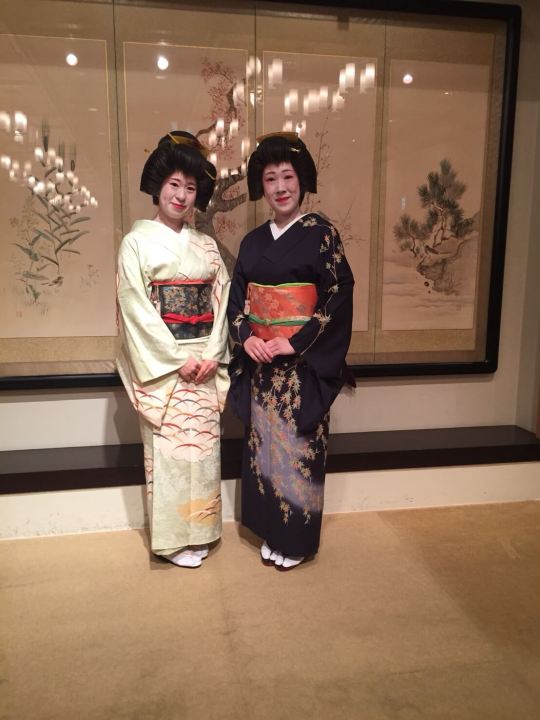
The look of Shimizu Geiko
Local Term: Geigi 芸妓
※ Hairstyle: Taka shimada, Tsubushi shimada
※ Kanzashi: Kushi, Maezashi, bekko kogai, ear of rice in the new year period
※ Kimono: Homongi, Kuromontsuki Hikizuri
※ Haneri: white
※ Obi: Taiko musubi
※ Obiage: green, pink, white, red
※ Obijime: flat, 1 knot
※ Footwear: Zori

Casual look
※ Hairstyle: Yohatsu
※ Kanzashi: none
※ Kimono: Homongi, rarely Komon
※ Haneri: white
※ Obi: Taiko musubi
※ Obiage: white, pink
※ Footwear: Zori

The look of Shimizu Maiko
Local term: Shinjin Geigi 新人芸妓
※ Hairstyle: Momoware Katsura, sometimes real hair styled (shin nihongami)
※ Kanzashi: seasonal and non-seasonal Hanakanzashi, Katsuyama, maezashi, Shidare in all age groups
※ Kimono: Furisode with shoulder tucks or no tucks at all
※ Eri: white with white embroidery, plain white, white with multicolour embroidery, other colours possible especially during summer months
※ Obi: Koken musubi
※ Obiage: flat, mostly red/silver, red/white shibori, other colours also possible (green/beige/light blue)
※ Obijime: flat or round with 1-4 knots. No obidome
※ Footwear: Zôri


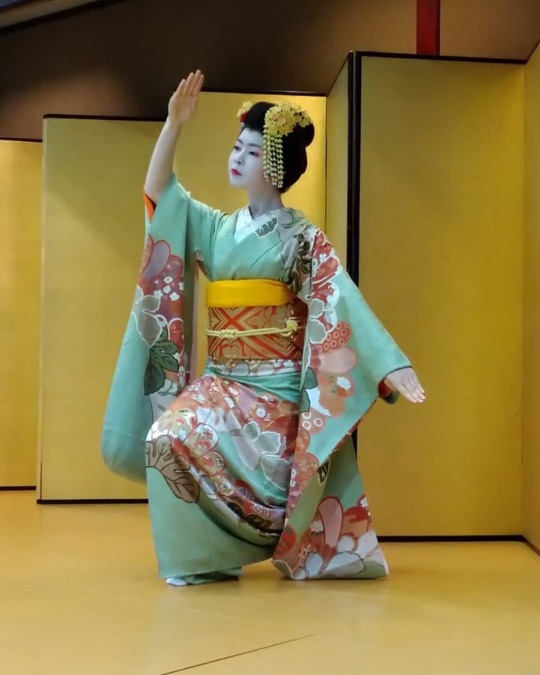

Notes
Shimizu was merged with Shizuoka in 2003. Shimizu Geigi and other traditional arts performers are backed by 静岡伝統芸能振興 Shizuoka dentô geinô Shinkô-kai/Shizuoka traditional performing arts promotion association, which is the successor to Seibikai. You might notice I didn't start this post with a historical b/w photo. There are some old photos on the Shizuoka Dentogeino homepage, but they are the size of a postal stamp. And that's it. I feel let down. No chance to explore the historical style of Shimizu.
Anyways. "The look of Shimizu/Shizuoka" was requested by @geimaiko. The layout of this post is based on geimaiko's own. Also... geimaiko originally started these series. If you liked this post, you should go and thank her, because without her, there would be no "the look of..." ;)
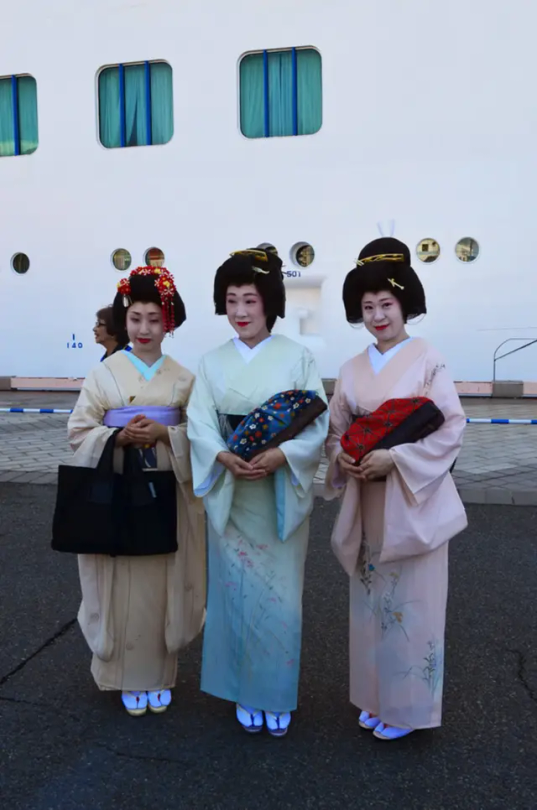

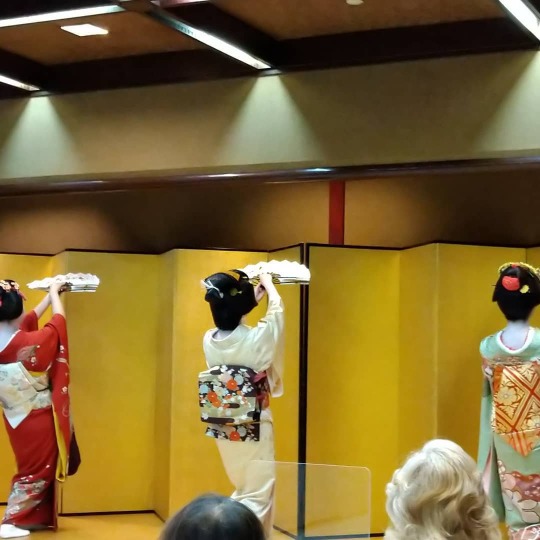
Sources
https://www.shizuoka-dentogeino.jp/geigi/shizuoka_history/, https://www.shizuoka-dentogeino.jp/geigi/shimizu_history/, http://www.shimizu-port.jp/geigi.html, https://www.nikkei.com/article/DGXNZO41971500Z20C12A5L61000/ (headline and preview only), https://www.youtube.com/@shizuokadentogeino/videos
Pictures: Komachi May 17, Makoto May 17, Komachi+Makoto Oct 17 (sources nowhere to be found), Sakurako+Fukutaro Apr 22, Kikuno+Umeka Nov 14, Iroha Jun 20, Iroha Oct 20, Fukutaro Oct 20, Ichiryo+Komachi+Makoto ~2016, Komachi+Sakurako Apr 18, Fukutaro+Sakurako Oct 18, Iroha+Fukutaro+Sakurako Oct 20
#mg#geisha#geiko#maiko#hangyoku#geigi#shizuoka#kimono#komachi#makoto#sakurako#fukutaro#kikuno#umeka#iroha
112 notes
·
View notes
Text
I’ve been dyeing!
I hosted two workshops this month - the first was a naturally dyed rainbow of wool miniskeins, using red (cochineal, madder), yellow (onion skins, osage orange), and blue (indigo) dyes and overdyeing to create a full spectrum of colors!
The wool was all premordanted with alum.

The second class was an itajime shibori class, creating mandala-style fabric panels by clamping tiles (acrylic) to create areas of resistance. Careful folding creates repeating patterns, and we dyed them in indigo.



#textiles#natural dyeing#natural dyes#indigo#cochineal#madder#historical textiles#los angeles#overdyeing#shibori#itajime#mandala#this has been a gdw original post
26 notes
·
View notes
Text




[Image Description: four pictures of dye projects. The first is a stitched Shibori dye of a yellow dragon with a black background. the second is a Katazome paste-resist technique with yellow bird patterns with green background. The next two photos are of a tunic made with the green fabric. The first lays flat. The second is a close up of it on a mannequin with a leather vest and belt. End ID]
I've been considering doing more dying projects. SO! If you're interested in buying any fabric, scarves, dresses, ect, in this natural-fiber hand-printing dying styles, please give a reblog!
#art#fiber art#textiles#artists on tumblr#inkwell art#interest check#I'm trying to find out if I should buy all the supplies to get myself started more Professionally
16 notes
·
View notes
Text
Undressing a Vintage Ichimatsu Doll

I put up a post a few days ago as I found this girl at a yard sale for $5… didn’t get any answers so I figured I would document the process if anyone else is interested! Photos under a read more..
Doing a little research, she is likely an ichimatsu doll- by the kimono pattern and dye style I would guess post-WWII Showa era. She does not have any geta or socks, I would assume they were lost. But otherwise has an incredible level of detail in her kimono! Basically, exactly what you would wear under a child’s furisode.
Her body is a mix of hollow clay (head, chest, lower arms, hips, and lower legs) and cloth parts which feel to be stuffed with a grass or straw. Her torso is covered in a piece of paper with a maker’s stamp.


Her kimono is silk, and her obiage is real shibori! But all is very wrinkled so I would like to press it back into shape. I did already work on her hair, will probably go back at it again when she is redressed.



When I untied the obiage and obijime, the back of the obi fell free. The main part of the obi is held with a metal snap.
Due to tumblr’s not great post editor, I am going to reply to this with more images!
5 notes
·
View notes
Text
From Classic to Contemporary: A Deep Dive into Tie Dye Fabric

Tie-dye fabric has an enduring appeal that spans centuries, from its ancient roots to its modern resurgence in fashion and design. Once seen as a symbol of counterculture in the 1960s, this vibrant fabric technique has evolved over time, finding its way into high fashion, home décor, and everyday wear. In this article, we’ll take a deep dive into the world of tie-dye fabric, exploring its history, techniques, and contemporary uses.
The Historical Roots of Tie Dye
The history of tie-dye fabric dates back thousands of years, originating in various cultures across the globe. The earliest forms of tie-dye can be traced to regions like India, China, and Japan, where artisans developed complex resist-dyeing techniques to create intricate patterns on fabrics.
India’s Bandhani: In the western Indian state of Gujarat, the tie-dye technique known as "Bandhani" has been practiced for over 5,000 years. This method involves tightly tying small sections of fabric with thread and then dipping it in dye to create beautiful, dotted patterns.
Japanese Shibori: Meanwhile, Japan has a long-standing tradition of Shibori, a method of folding, twisting, and binding fabric before dyeing. The result is a range of striking patterns, from geometric shapes to organic, flowing designs.
West African Adire: In Nigeria, the Yoruba people have perfected the Adire technique, which uses a resist-dye method with indigo to produce bold and culturally significant patterns.
These early forms of tie-dye were not just decorative but often carried symbolic meanings, signifying social status, cultural identity, or spiritual significance.
The Rise of Tie Dye in the 1960s and 70s
Fast forward to the 20th century, tie-dye became synonymous with the counterculture movements of the 1960s and 70s, particularly in the United States. Hippies embraced tie-dye as a form of self-expression and rebellion against societal norms. Its vibrant, unpredictable patterns represented freedom, individuality, and a break from conformity.
During this era, the process of creating tie-dye fabric became more accessible. Instead of the traditional methods that involved natural dyes and labor-intensive techniques, tie-dye kits with synthetic dyes became widely available, allowing anyone to create their own psychedelic designs at home.
Tie Dye in Contemporary Fashion
In recent years, tie-dye has made a bold comeback in mainstream fashion, transcending its counterculture roots to become a staple in wardrobes around the world. Modern designers have reimagined tie-dye for the contemporary audience, incorporating it into high-end fashion, streetwear, and even minimalist styles.
High Fashion: Renowned fashion houses like Dior and Prada have incorporated tie-dye into their collections, using luxurious fabrics and sophisticated color palettes to give the traditional technique a modern twist.
Streetwear: Brands like Supreme and Off-White have embraced the nostalgic appeal of tie-dye, often combining it with bold logos and graphics to create a fresh, urban look.
Eco-conscious Fashion: The rise of sustainable fashion has also given tie-dye a new purpose. Many eco-friendly brands now use organic dyes and upcycled fabrics, tapping into tie-dye’s artisanal roots while promoting ethical consumption.
Techniques: How Tie Dye is Created
There are several popular techniques used to create tie-dye patterns, ranging from simple to complex. Each method results in unique designs that make every tie-dye piece one-of-a-kind. Here are a few of the most common methods:
Spiral Technique: Perhaps the most recognizable, the spiral pattern is achieved by twisting the fabric into a tight circle and applying different dyes in sections. The result is a vibrant, swirling design.
Crumple Technique: For a more abstract look, the crumple method involves scrunching the fabric randomly and applying dye for a marbled effect.
Fold-and-Bind Techniques: This method, which includes designs like stripes, squares, and diamonds, is achieved by folding the fabric in different directions and binding it with rubber bands before dyeing.
These simple techniques are easily done at home, but experienced artisans can create incredibly intricate designs using more advanced resist-dyeing methods, such as stitching or wax-resist techniques.
The Versatility of Tie Dye Fabric Today
Beyond fashion, tie-dye has found a home in a variety of industries, thanks to its versatility. It’s used in everything from home décor to crafting, as people continue to be drawn to its vibrant colors and unique patterns.
Home Décor: Tie-dye isn’t just for clothing. Home décor items like pillows, curtains, and bed linens are now being crafted using tie-dye techniques, bringing an element of bohemian chic into modern interiors. The unpredictability of tie-dye patterns makes each piece a statement item.
Crafting: Tie-dye has also become a popular medium for DIY projects, allowing people to create personalized, handcrafted items like tote bags, scarves, and even face masks.
Textile Art: In the world of contemporary art, tie-dye fabric has emerged as a medium for textile artists who push the boundaries of traditional dyeing techniques to create gallery-worthy pieces.
Conclusion: The Timeless Appeal of Tie Dye
From its ancient origins to its present-day popularity, tie-dye fabric has proven itself to be more than just a fleeting trend. Its ability to evolve while retaining its unique charm ensures that tie-dye will continue to captivate designers, artists, and consumers for years to come.
Whether you’re wearing it as a fashion statement, incorporating it into your home, or using it as a canvas for your creativity, tie-dye fabric offers endless possibilities for self-expression and artistry.
For high-quality tie-dye fabrics and a range of designs, visit Dmaasa.com or reach out to customer service at [email protected] or +91 9667766779 for any inquiries.
4o
0 notes
Text
Embracing Freedom and Craftsmanship: A Guide to Hippie Clothes for Men and Handmade Hippie Fashion
Hippie clothes for men embody a distinctive blend of freedom, comfort, and individuality that continues to resonate with many today. Rooted in the countercultural movement of the 1960s and 1970s, hippie fashion represents more than just a style; it's a statement of personal expression and a celebration of nonconformity. For those embracing this aesthetic, handmade hippie clothing offers an authentic and unique way to connect with the spirit of the movement.
Embracing the Hippie Look
Hippie Clothes for Man is characterized by its relaxed, bohemian vibe. Key elements include loose-fitting garments, earthy colors, and a mix of textures and patterns. Men’s hippie wardrobes often feature items such as tie-dye shirts, fringed vests, wide-legged trousers, and flowy, embroidered tunics. These pieces are designed to provide comfort while allowing the wearer to express their individuality and creativity.
The Allure of Handmade Clothing
Handmade Hippie Clothing adds an extra layer of authenticity and personal touch to the hippie look. Unlike mass-produced garments, handmade clothing is crafted with care and attention to detail, often using traditional techniques and natural materials. This not only ensures a unique, one-of-a-kind piece but also supports artisans who practice their craft with passion and skill.

Handmade garments often incorporate vibrant prints, intricate embroidery, and unique dyeing techniques. For instance, hand-tied dyeing methods, such as shibori or batik, result in patterns that are both visually stunning and deeply personal. These techniques offer a way to wear a piece of art that reflects the wearer’s values and aesthetic.
The Eco-Friendly Aspect
A significant aspect of handmade hippie clothing is its alignment with sustainable and eco-friendly practices. Many artisans prioritize using organic or recycled materials, minimizing waste, and avoiding harmful chemicals. By choosing handmade garments, consumers support environmentally responsible practices and contribute to a more sustainable fashion industry.
Creating Your Hippie Wardrobe
Building a hippie wardrobe can be a delightful and fulfilling experience. Start with versatile basics such as comfortable, well-fitted jeans or cargo pants, which can be paired with a variety of tops. Opt for handwoven shirts or jackets featuring unique patterns or motifs to add character. Accessories like beaded necklaces, leather belts, and wide-brimmed hats can further enhance your look.
When seeking handmade items, explore local markets, craft fairs, and online platforms that specialize in artisanal goods. Supporting small businesses and independent artisans not only ensures that you receive high-quality, distinctive clothing but also promotes a more ethical approach to fashion.
In conclusion, hippie clothes for men and handmade hippie clothing offer a meaningful way to embrace a style that celebrates freedom, individuality, and sustainability. By choosing garments that reflect these values, you not only enhance your personal style but also contribute to a broader movement towards ethical and creative fashion. Whether you’re drawn to the vibrant patterns of tie-dye or the intricate craftsmanship of hand-embroidered pieces, incorporating handmade hippie clothing into your wardrobe allows you to express your unique identity while honoring the principles of the hippie ethos.
0 notes
Link
Check out this listing I just added to my Poshmark closet: WILDFOX Purple & White French Terry Oversized Relaxed Fit Tie-Dye Hoodie XS.
0 notes
Text
Buy Shibori Tie Cotton Saree | Blockart
Looking for a unique and stylish saree to add to your collection? Check out blockart Shibori Tie cotton saree! Our Shibori Tie cotton sarees are made from high-quality cotton fabric that is lightweight, breathable, and comfortable to wear. These sarees come in a variety of vibrant colors and eye-catching designs, making them perfect for any occasion, from casual to formal. Whether you're looking for a saree for a wedding, a party, or any other special occasion, our Shibori Tie cotton sarees are sure to make a statement. Shop our collection of Shibori Tie cotton sarees today and add a touch of elegance and style to your wardrobe.

0 notes
Text
Shop Elegant Tie-Dye Shibori Cotton Suit with Chiffon Dupatta - Ethnic Adda
Discover the elegance of our Tine Dye Shibori Cotton Suit with Chiffon Dupatta at Ethnic Adda. This stunning ensemble combines traditional craftsmanship with modern style, perfect for any occasion. Shop now to add a touch of sophistication to your wardrobe.
0 notes
Text
Discover the Magic of Global Fusion Interior Design with WeDezine
In today’s interconnected world, interior design is no longer confined to a single style or culture. Instead, it’s evolving into a beautiful tapestry that weaves together diverse influences from around the globe. At WeDezine, we are passionate about creating unique and personalized spaces that reflect this cultural fusion, which we call Global Fusion Interior Design. Our latest blog post delves into this exciting concept, offering inspiring ideas to help you incorporate global elements into your living spaces.
What is Global Fusion Interior Design?
Global Fusion Interior Design is about blending elements from various cultures to create a harmonious and eclectic style. Imagine the serenity of Japanese minimalism paired with the vibrant patterns of Moroccan decor, or the clean lines of Scandinavian design infused with the rich textures of African art. The key is to create a balance that brings a cohesive yet diverse aesthetic to your home.
Highlights from Our Blog
Embrace Eclectic Mixes: Start with a neutral base and layer on colorful textiles, unique furniture pieces, and art from different regions. This approach allows for a harmonious blend that is both cohesive and visually striking.
Cultural Artifacts and Decor: Add authenticity and character to your home with artifacts and decor items from various cultures. Handwoven rugs, ornate lamps, and traditional tapestries can tell a story and personalize your space.
Fusion Furniture: Opt for furniture that combines different cultural aesthetics. Custom-made pieces can seamlessly blend modern and traditional elements for a standout look.
Global Color Palettes: Use color palettes inspired by different regions to bring vibrancy to your home. Mediterranean blues, Indian pinks, and African earth tones can create a dynamic environment.
Layered Textiles: Mix different fabrics from various cultures to add depth and texture to your interiors. Persian rugs, Japanese shibori, and Mexican serapes can coexist beautifully.
Worldly Greenery: Enhance your space with plants from around the world. Bonsai trees, succulents, and tropical plants can add life and freshness to your home.
Art and Photography: Displaying art and photography from different cultures can create a gallery-like feel. Curate a gallery wall with frames of different sizes and styles for visual interest.
Handcrafted and Artisanal Pieces: Incorporate handcrafted items that showcase traditional craftsmanship from around the world. Support local artisans and fair-trade markets for authenticity and sustainability.
Why Choose Global Fusion for Your Home?
Global Fusion Interior Design is about celebrating diversity and creating a home that reflects your unique taste and experiences. It’s an approach that brings cultures together, creating spaces that are not only beautiful but also meaningful. At WeDezine, we believe in the power of design to tell your story and transform your home into a global haven.
Ready to Transform Your Home?
If you’re inspired to infuse your home with global charm, we’re here to help. Contact WeDezine today to start your journey towards a beautifully blended interior that speaks to your soul. Explore our blog for more ideas and let us guide you in creating a space that is truly your own.
Connect with WeDezine
Stay updated with the latest trends in interior design by following our blog and social media channels. Join the WeDezine community and discover how Global Fusion Interior Design can transform your living space into a celebration of world cultures. Let’s create a home that tells your story, one design element at a time.
0 notes